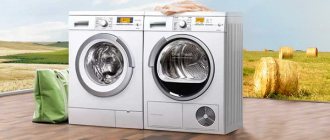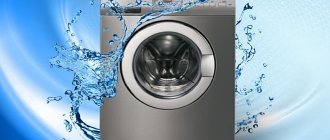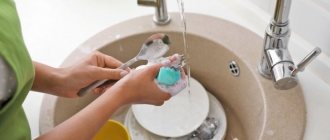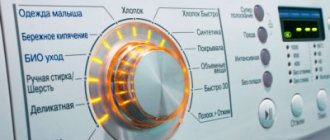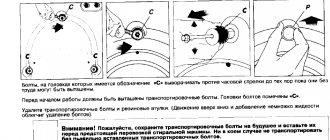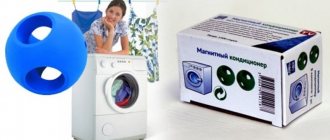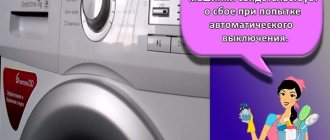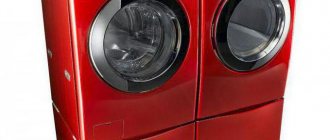The power of a washing machine is a parameter indicating the amount of electricity consumed by the unit. In conditions of total savings and rising prices for utilities, this indicator is not in last place when choosing household appliances. In this article we will tell you how to determine how much power a washing machine has and avoid unnecessary energy costs when using the unit.
The issue of careful energy consumption is relevant for most washing machine users
Electricity consumption
The amount of electricity used is determined by the following indicators:
- unit power;
- selection of modes that ensure rational consumption of resources.
The efficiency characteristics of the equipment are indicated in the energy consumption class. It is recommended to choose class A products, perhaps with one or two pluses, or B.
The specified equipment consumes on average from 0.8 to 1 kWh during one operation. During one wash, the power ranges from 300 W to 2 kW, depending on the selected mode and unit parameters.
Approximate calculation of energy consumption for 2 weekly washes of 3 full cycles per week for a machine that spends 1 kWh per full cycle:
- 6 kWh will be consumed in a week;
- per month – up to 25 kWh;
- the cost of electricity used per month by an automatic machine, at a tariff of 3 rubles. is: 25*3=75 rub.
The calculated indicators may differ depending on the intensity of use of the equipment and the degree of soiling of the laundry, which affects the choice of mode.
This is interesting: Which bowl is better for a multicooker - which coating to choose: non-stick, ceramic, stainless steel
Energy consumption table for household appliances
For each home, the number of electrical devices, the value of their electricity consumption and the duration of operation will be different. The table below for energy consumption of household appliances contains average information:
| Device name | power, kWt | Operating time per day, h | Consumption per day, kWh | Consumption per month, kWh |
| Fridge | 0,15-0,6 | 24 | 3,6-8,6 | 10,8-25,8 |
| Lighting (10 lamps 20 W each) | 0,020 | 5 | 0,1 | 3 |
| Washing machine | 1-2,2 | 1 | 1-2,2 | 20-30 |
| Vacuum cleaner | 0,65-2,2 | 15 minutes | 0,16-0,55 | 1,6-5,5 |
| TV | 0,1-0,3 | 5 | 0,5-1,5 | 15-30 |
| Microwave | 1,5 | 30 minutes | 0,75 | 10-15 |
| Electric kettle | 0,7-3 | 15 minutes | 0,25-0,75 | 7,5-16,5 |
| Computer | 0,1-0,2 | 5 | 0,5-1 | 7-20 |
| Iron | 1,1 | 15 | 0,3 | 5-8 |
| Dishwasher | 0,5-2,8 | 1 | 0,5-2,8 | 7,5-15 |
| Multicooker | 0,2-2,4 | 1 | 0,2-2,4 | 2-24 |
| Food processor | 0,2-2,0 | 15 minutes | 0,05-0,5 | 0,5-3 |
| Air conditioner | 0,7-1,3 | 7 | 3,5-8 | 15-35 |
| Hairdryer | 1,2-1,5 | 15 minutes | 0,3-0,4 | 5-7 |
| Heater | 1,5 | 5 | 7,5 | 75 |
| Electric stove | 2-8,5 | 3 | 5-10 | 30-150 |
| Coffee maker | 1,5-3,5 | 15 minutes | 0,3-0,8 | 5-10 |
| Hood | 0,1-0,5 | 3 | 0,3-1,5 | 3-4,5 |
Classification of washing units
All household appliances are divided according to their efficiency in consuming electrical energy into certain classes, designated by Latin letters from A to G. The “+” sign is also added to them: for example, the most economical product is considered to be the one with the “A++” sign.
To calculate the number of kilowatts per kg, special laboratory tests are carried out, after which household appliances are assigned a certain class:
- The most economical units are considered to be “A++” class units. This is the minimum electrical energy consumption: 0.15 kW/h per 1 kg.
- Next comes class “A+” - less than 0.17 kW/h x 1 kg.
- Class “A” is average, its energy consumption is in the range of 0.17-0.19 kW/h for washing 1 kg of laundry.
- A product with the letter “B” will need 0.19–0.23 kW/h for a similar operation.
- Class “C” consumes 0.23-0.27 kW per hour when washing one kg of laundry.
- A washing unit with the letter “D” will consume 0.27–0.31 kW/h under the same washing conditions.
Further listing does not make sense, because modern household appliances no longer use them for washing - these classes will require much more electrical energy consumption. During laboratory studies, washing occurs at 60
0
C with maximum load of cotton laundry. In real life, everything happens a little differently, so this parameter may be completely different for your assistant.
How to determine power
Power consumption is calculated practically in a special laboratory. Experts calculate the kWh consumption rate per 1 kg of loaded laundry. The test is carried out under equal conditions for all models: a full washing cycle is launched with the maximum permissible drum load (for example, 6 kg) and a water heating temperature of +60 ℃. Cotton items are used as linen. After receiving the results, the machine is assigned the appropriate energy consumption class.
The easiest way for the user to determine the power of the unit is to read the technical characteristics. They are indicated in the device passport or on the information sticker on the machine body. There are several classes of energy consumption. The general energy efficiency scale is indicated by letter codes from A to G. Classes A and B are at the highest level of energy saving, classes C, D and E are at the average level, and classes F and G are at the lowest level.
This is what the power designation sticker on the front panel of the unit looks like
Another example of power designation on the body of a washing machine
Modern units most often have energy efficiency classes A, B or C.
Today, the most economical models of washing machines are marked A+, A++, A+++. These are advanced energy efficiency classes that provide maximum energy savings while maintaining high quality washing. Below is a table of the relationship between electricity consumption and energy efficiency class.
| Energy efficiency class | Efficiency index (kW/hour per 1 kg of laundry) |
| A+++ | Less than 0.13 |
| A++ | 0,13-0,15 |
| A+ | 0,15-0,17 |
| A | 0,17-0,19 |
| B | 0,19-0,23 |
| C | 0,23-0,27 |
| D | 0,27-0,31 |
| E | 0,31-0,35 |
| F | 0,35-0,39 |
| G | More than 0.39 |
The index shows how many kilowatts a washing machine consumes in 1 hour of washing 1 kg of laundry. Using this data, you can calculate the approximate power consumption for your device.
When calculating, do not forget about the individual parameters of each individual washing cycle - they can both save energy and increase electricity consumption.
Washing machines with a drying function have their own energy consumption indicators, which must be taken into account when choosing a home assistant. The same initial data are used for calculations as for conventional machines. Below is a table showing the relationship between index and efficiency class in washing machines with drying functions.
| Energy efficiency class | Efficiency index (kW/hour per 1 kg of laundry) |
| A | Less than 0.68 |
| B | 0,68-0,81 |
| C | 0,81-0,93 |
| D | 0,93-1,05 |
| E | 1,05-1,17 |
| F | 1,17-1,29 |
| G | More than 1.29 |
As you can see, when using the drying function, energy consumption increases, which must be taken into account when choosing this option.
Electricity consumption by individual nodes
Each washing program requires a certain amount of electricity and, accordingly, different programs consume different amounts of energy. In a general sense, energy is spent on:
- spinning the drum;
- heating water and maintaining the set temperature;
- maintaining the overall wash rate.
Motor
The intensity of rotation of the drum depends on the operation of the engine. They are very different and with different energy consumption. In modern washing machines, electric motors have a power of up to 0.9 kW/h. During the spin cycle, the motor has to consume a little more energy than required for a normal wash.
Electric heater
As is already clear from the name of this device, its task is to heat the water in the drum to the required value in a given washing program. Some washing modes may exclude the heating element from operation if the water does not need to be heated. Accordingly, the energy consumption is less. There are also opposite situations when the heater operates at full power. The speed and temperature of water heating are proportionally related to the energy expended . The consumption of this device is up to 3 kW/h.
Pump
One of the most economical parts of the SMA. Consumes only about 40 Wh. The pump is activated in all washing programs. Its function, which is probably already clear, is to pump water out of the washing machine drum.
Control Panel
And finally, the most economical part of the machine – up to 20 Wh. This is the same panel where you need to select a washing program and specify additional parameters.
What elements of the machine consume electricity?
To determine the power of the unit, you first need to find out which elements of the device “eat up” most of the electricity. These include:
- The electric heater (TEH) is designed to heat water in the tank. The intensity of its work depends on the selected program and washing stage. If for the boiling mode the heating element operates at full power, then when washing in cold water it may not turn on at all during the entire process. Any heater built into the machine has its own power rating, which varies between 1.7-2.9 kW. The higher the number indicated, the faster the water heats up and the more energy is consumed during operation.
- The engine is the main element of the machine that ensures the rotation of the drum. In modern models, different types of motors are installed - asynchronous, inverter or commutator. The power of the washing machine motor depends on its type. On average, the figure varies from 0.4 to 0.8 kW (400-800 Watts). The most energy is consumed during the spin phase.
- The control unit is a system of parts that allows you to control the processes of the unit. These include an electronic board, sensors, a programmer, light bulbs, starting capacitors and other control-related elements. The entire system consumes about 5-10 watts.
- The pump (pump) is used at different stages of the machine’s operation when it is necessary to pump out used water from the tank. To perform its function, the part consumes little electricity - from 25 to 45 watts.
The power consumption of the unit depends most on how much energy the motor and electric heater consume.
Electricity consumption is determined by the selected washing program. Each mode is designed for a specific water heating temperature, cycle duration and intensity, and the number of drum revolutions during normal washing and during the spin phase. Energy consumption is influenced by the weight of the clothes loaded and the type of fabric, as well as the selected additional functions - rinsing, drying, light ironing, etc.
The amount of electricity consumed also depends on the selected program and its duration
An important factor is the service life of the device. Over time, the heating element accumulates salt deposits, which impedes heat transfer. To heat the water to the desired temperature, the heater has to “work” harder, which means more electricity is required.
Washing machine efficiency classes
How much power your washing machine consumes depends on which electrical energy consumption class it belongs to.
All devices are designated by the Latin alphabet from A to G. For example, the letter “A++” means that this is the most economical model in terms of energy consumption.
When assigning a washing machine one or another energy consumption class, special laboratory tests are carried out.
The parameter is measured during washing at 60 degrees with a full load of cotton laundry.
Based on the experiment, the unit is assigned the appropriate class:
- “A++” is the minimum electricity consumption of 0.15 kW/h per kg of laundry;
- for class “A+” the electricity consumption is slightly higher than for “A++” - 0.15 - 0.17;
- the average type is “A”, which consumes from 0.17 to 0.19 kilowatts;
- marking “B” – in the range of 0.19–0.23;
- a class “C” device consumes 0.23–0.27;
- a car with the letter “D” under the same conditions consumes electricity from 0.27-0.31.
Washing machines marked: E, F, G are currently no longer produced. They are very energy-intensive, consuming more than 0.31 kilowatts per hour per kg of laundry.
What determines the power of a washing machine?
The expended power of a washing machine consists of the expended energy of its main components:
spins the drum, the more revolutions, the higher the consumption. In addition, engines come in several types:
Engine
- asynchronous with a power of no more than 400 watts, which are no longer in use, but the old unit most likely has just such a motor;
- all new models operate on commutator and inverter motors, which consume up to 800 watts depending on the wash selection.
Is it only the power of appliances that affects electricity consumption? Of course not, this includes program selection, washing modes, drum load, and even the condition of household appliance components.
When purchasing a washing machine, please note:
- equipment with vertical loading of laundry is more economical due to its small dimensions, but it is also suitable for a small family;
- if a spacious drum is important to you, then you should study all the models with a large drum and choose the one with the most economical class;
- when choosing dimensions, focus on the load of laundry that will further satisfy your needs, for example, they are already producing small-sized machines with a depth of 40 cm with a load of 4.5 kg of laundry, washing power consumption is class “A”.
What else does the email depend on? washing machine power?
The choice of washing mode directly affects the energy consumption. Consumption increases the water heating temperature, wash duration, rinse time, drum speed during spinning, and additional functions.- Washing polyester will require much less energy than cotton and linen. In addition, these fabrics vary significantly in dry and wet weight.
- The larger the tank load, the higher the electricity consumption.
What affects refrigerator consumption?
The energy consumption level of a refrigerator may vary due to various factors. This should be taken into account when choosing a model of household appliances and placing them in the house.
Effect of temperature
Each refrigerator comes with instructions that contain the requirements for its installation. This applies not only to free-standing equipment, but also to built-in ones. Neglecting these recommendations will result in excessive consumption of electricity and rapid wear of the unit.
Ideally, appliances should be placed in a room where the temperature is maintained from +18 to +20 C. It is in such conditions that the level of electricity consumption by refrigerators will be the most economical. At +30 C and above, electricity consumption can double. Unheated rooms are also not suitable for installing units. Negative temperatures can quickly damage a heat pump, causing the compressor to stop turning on.
Heat sources should not be located near household appliances: stoves, ovens, heating radiators. Care should be taken to ensure that the unit is not exposed to sunlight, which can heat its walls.
Compressor power
The compressor is the engine of the refrigerator, ensuring the movement of freon, due to which the chamber is cooled to a predetermined temperature. The efficiency of the compressor determines the power of the unit.
Some models have two compressors: in the refrigerator and in the freezer compartment. When choosing such a device, you should make sure that it has an asynchronous operating principle.
Linear compressors have begun to be installed in modern refrigerators. They ensure constant movement of freon, as a result of which electricity is consumed evenly. Such devices are more expensive than standard options, but they are safer and more economical.
Freezing power of refrigerators
Freezing power is the mass of products that the freezer compartment of the device can freeze to t -18 C per day. In the instructions and on the sticker, this indicator is indicated as an X with asterisks, the number of which indicates the effectiveness of freezing
For example, a family of four should pay attention to a device with a freezing capacity of 10 kg/day
Freezing power is indicated on the device and in the instructions
The amount of electricity a freezer consumes is influenced by a number of factors:
- chamber volume for freezing products;
- compressor power;
- amount of loaded food;
- room temperature.
At the same time, the type of control panel and camera lighting do not affect the efficiency of the equipment.
Energy efficiency classes
According to international standards, refrigeration equipment is divided into classes: A+++, A++, A+, A, B, C, D, E, F, G. Each of them reflects the level of energy consumption of refrigerators.
In addition, there is a COP factor. From it you can find out how many times more the equipment can remove heat than consume electricity. For example, if this indicator is 3, this indicates that the device will spend 1 kW to remove 3 kW of heat.
COP varies depending on the energy efficiency class:
- A+++, A++, A+ – about 3.6;
- A – from 3.4 to 3.6;
- B, C – from 2.8 to 3.4;
- D, E – from 2.6 to 2.8;
- E, F – from 2.2 to 2.6;
- G – less than 2.2.
Energy classification
Taking into account the fact that washing occurs regularly, at least 5 kg of clothes are placed in the drum each time, and the program sometimes takes up to 2 hours to complete, the average level of energy consumption of the washing machine affects the financial costs of the owner. As tariffs increase, the level of electricity consumption becomes especially relevant for every owner of household appliances. Nowadays, most buyers are interested in what power the washing machine they want to purchase has. Usually this indicator can be seen on a sticker glued to the AFM body.
Today, the Common European Electricity Consumption Standard for washing household appliances has been adopted. The class is assigned based on power consumption per 1 kg of laundry washed. The unit of measurement is kilowatt per hour (kW/h). One kilowatt (kW) is equal to 1000 watts (W). Measurements are carried out in laboratory conditions. For washing, all automatic machines use the same reference cotton fabric, the water is heated to +60 °C, and the washing program is also the same.
The most economical electricity consumption class today is A+++. According to the requirements of the classifier, AFM must consume less than 130 W/h. It is followed by A++, which allows consumption from 130 to 150 Wh. Level A+ requires consumption from 150 to 170 Wh. Class A is also considered excellent in terms of energy consumption - from 170 to 190 Wh.
Other classes cannot be called economical. Class B means that the unit can consume from 190 to 230 Wh. Class C corresponds to a consumption of 230–270 Wh. Letter D indicates that the owner uses a washing machine that consumes 270–310 W/h. Lower classes - E, F and G - are not worth considering. Currently, there is no need to purchase household washing appliances whose energy consumption is below class A.
This is interesting: Rating of the best Vitesse multicookers of 2022 (TOP 6)
Indesit IWSB5085
Model Indesit IWSB5085 is a free-standing washing machine with the ability to be built-in. It has a front-loading type of laundry, designed for 5 kg. Has electronic control. Switching and selection of programs is carried out using rotary switches and buttons. Unfortunately, there is no display, so you won’t be able to see the remaining time of the program.
Energy consumption is quite low, using only 43 liters of water per cycle, and electricity – 0.95 kW/h, which is very little. It washes well, washing efficiency class A. There are 16 programs, although half of them are only variations of the main ones. For example, you can wash cotton in 6 different modifications - soaked, heavily soiled, dyed, delicate, etc.
In addition, there are programs for sportswear, silk, jeans, wool and a short Express 15 mode for refreshing lightly soiled laundry. The water temperature in various programs can be from 90 to 30 degrees. The spin is of poor quality, only efficiency class D, which means that the laundry remains very damp. The maximum number of possible revolutions is 800 rpm.
indesit-iwsb5085-1
indesit-iwsb5085-2
indesit-iwsb5085-3
Indesit IWSB5085 has a delay start timer from 3 to 12 hours. Protection against leaks is partial (body), there is control over imbalance (the laundry is evenly distributed throughout the drum before spinning) and foam level (preventing excessive foaming if there is too much detergent).
I would consider the advantages of the model:
- small price, but the quality of washing is good;
- consumes little water and electricity;
- there are several “sport” modes;
- there is a timer.
There are also disadvantages:
- noisy work;
- bad spin;
- Water remains in the powder tray.
Video presentation of washing machines of this series in a video from specialists:
https://youtube.com/watch?v=r0fV—zgcW0
Energy consumption classes
When buying an automatic washing machine, you have to focus on many criteria, including energy consumption. No matter how useful a washing machine is, if it consumes a lot of electricity, it will eat up your budget through utility bills.
But it’s really worth paying attention to equipment that not only washes efficiently, but also consumes a minimum of electricity.
Even 20 years ago, the countries of the European Union came up with a classification for washing machines. Latin letters are used to designate it. And from now on, every household appliance must have a special sticker indicating its energy intensity. This way, the buyer can easily compare models based on their energy consumption and determine which ones are the most efficient.
On average, 2.5 million washing machines are sold worldwide per year. They account for the highest share of household appliance production. The EU classification of washing machines was adopted not only for the convenience of users, but also to increase the quality of products. Since 2014, every washing machine model released has had to be rated according to its energy consumption system, and the growing capabilities of leading companies have increased the scale to A+++ , which means that the product consumes a minimum of energy.
However, this system also has disadvantages. For example, it ignores the durability and performance of a washing machine. The power consumed by any household appliance is measured in Watts. But not every sticker indicating the energy efficiency class has specific numbers. By the letter designations you can understand how much electricity the device uses:
- A++ is the most economical class; for 1 kg of laundry, machines of this class consume electricity in the amount of 0.15 kW/hour;
- A+ is a slightly less economical option, cars of this class consume 0.17 kW/hour;
- Category A cars consume 0.19 kW/hour;
- category B consumes 0.23 kW/hour;
- category C – 0.27 kW/hour;
- category D – 0.31 kW/hour;
- category E – 0.35 kW/hour;
- category F – 0.39 kW/hour;
- category G consumes more than 0.39 kW/hour.
In other words, Class A equipment uses electricity on average 80% more efficiently than equipment of lower classes. However, it is now rare to find a machine whose energy efficiency is lower than class D or E. On average, a washing machine is used about 220 times per year, which is equal to approximately 4-5 washes per week or 22-25 washes per month, and the water heats up to 50-60 degrees. Based on these values, the energy efficiency of household appliances is calculated.
Criterias of choice
Before choosing a washing machine, familiarize yourself with the main criteria by which devices differ from each other: size, capacity, operating efficiency, control and software, additional features. I will dwell in detail on each point.
Dimensions and capacity
Washing machines, designed for 5 kg of laundry, come with front and vertical loading of the tank. I am considering frontal units, so I will describe their dimensions. The height of such machines is 85-90 cm, width - 60 cm, depth - 32-45 cm. Front-loading machines require a hatch in front of the machine with a transparent glass door through which the drum is visible.
You must take into account that it is necessary to leave space in front of the machine for comfortable opening of the loading hatch. The capacity of narrow models is 5-6 kg of laundry. This performance will be quite enough for 3-4 people.
Control and software set
These units have electronic control, which, depending on the model, has the following differences: the presence or absence of a display, the selection of programs and parameters can be made using a rotary lever, mechanical or touch buttons.
Regarding the set of programs, here we have, in addition to standard modes (cotton, synthetics, colored clothes, delicate wash), several additional options:
- pre-wash – the washing cycle is increased by 15 minutes, due to which heavy soiling is removed;
- degree of pollution – allows you to use exactly the amount of resources that is most efficient and economical. All you need to do is determine how dirty things are and set the appropriate parameters to the program;
- additional rinse – increases the amount of water in the rinse cycle to better rinse the detergent from the laundry fabrics. This option will be very relevant when washing children's clothes.
- special washing programs - children's clothes, sportswear, jeans, wool.
Efficiency and economy
Energy efficiency is an indicator of the electricity consumption of a device; the higher it is, the more economical the device is. The highest class is A++, these days this is not very uncommon, but still more often you will find A+ or A. The lowest rating is G, which means the most wasteful model. Of course, the higher the class, the more expensive the device.
The washing class of all appliances is usually A, that is, maximum. For the spin class, A is also the highest rating, but you may find B or C, which indicates an average spin job (the laundry is quite damp).
Additional features
Additional functions of the machine may include:
- delay start timer - allows you to set a convenient end time for washing;
- AquaStop system - a set of sensors that are triggered if there is a leak and block the access of water to the device;
- imbalance control – distribution of items in the drum before spinning for quieter and longer-lasting operation of the machine;
- surge protection - a device that stops the supply of electricity in the event of sudden power surges;
- Child lock – protects your nerves and device from little helpers. The system locks the door and control keys during operation.
Types of cars
All washing machines are conditionally divided according to the following criteria:
- Vertical or horizontal loading of laundry. The way you load and unload laundry affects how much electricity your household appliance consumes. Since equipment with vertical loading of laundry is produced in minimal dimensions, it is beneficial only for small families.
- Capacity. The number of kilograms of dry laundry you can hold and its texture have a direct impact on the speed of the motor, which determines the speed of the drum and how hard the washing machine will work. Accordingly, if you purchase large-capacity household appliances, it is best to pay attention to the most economical energy consumption class.
- Dimensions of the washing machine. The dimensions of modern household appliances are always proportional to the capacity parameters, as well as energy consumption indicators. Therefore, some consumers argue that how long the equipment will occupy, so much energy it will consume. For example, if you have a family of several people, then when purchasing, you can choose a small washing machine, thereby reducing energy consumption.
Based on the above criteria, when purchasing an automatic washing machine, you can initially determine how much electricity the equipment consumes in each operating mode, having learned the class and familiarized itself with the technical characteristics.
Advice:
Is it worth pursuing savings?
It’s great if the washing machine’s power consumption is minimal. But besides this, you should understand that an SMA that does not rinse and wash well will be of little use. Therefore, when deciding on a model, a certain balance should be maintained.
Water consumption and watt indicators are interrelated. If the SM collects a little water for washing, it will be easier to heat the liquid, therefore, electricity consumption will be reduced. Also, a tank in which there is little water is easier to rotate, and this also reduces the number of “wound” kW. When choosing an automatic machine, you should decide for yourself whether such savings are needed. Is it worth buying a super-economical machine that cannot rinse clothes well?
Interesting:
- Atlant washing machine power
- Bosch washing machine power
- Candy washing machine power
- Dishwasher power in kW
- Dimensions of the Indesit washing machine
- What is the power of the clothes dryer in kW?
Reader comments
- Share your opinion - leave a comment
What does consumption depend on?
A modern automatic washing machine is a complex multifunctional device that heats water, washes clothes, spins them and drains the water. And some models also dry it. So let's figure out what wastes the most light in a washing machine.
The energy consumption of a washing machine is affected by:
- Electric motor. It rotates the drum through a belt or direct drive. Modern devices use commutator or brushless motors (on inverter models). Its power consumption ranges from 400–800 W and depends on the specific model of the machine and the drum load (not significantly).
- The power of the heating element heats the water. Its power is about 2 kW.
- Water drain pump – approximately 40 W.
- Standby control system – 3–10 W.
As you can see, the main energy consumption of a washing machine comes from the drum drive and electric heater (TEH), but they do not work all the time, but periodically. But adding the above power in W and multiplying it by time to get the consumption per hour will not be the correct solution for calculations.
The fact is that during washing the machine consumes different power, it depends on the operating mode and engine speed. In addition, the water is not heated continuously, but over a certain period of time. After heating the water to the specified temperature, the heating element turns off.
How much a machine actually consumes in 1 wash cycle is influenced by 3 main factors:
- Water temperature.
- Number of spin revolutions.
- Loading the drum.
How to save electricity
In conclusion, we will give 3 tips for saving energy consumption of an automatic washing machine:
- Load the car completely. Don't wash one T-shirt at a time. Electricity consumption will be almost the same as when fully loaded.
- Lower spin speed. There is no need to set maximum spin speeds without an objective reason for this. At higher speeds, the engine consumes a little more current, and not all things can be spun at that speed. This also applies to the water temperature; you should not set it to the maximum; most stains can be washed off in warm water. It is better to pre-soak particularly dirty laundry.
- Clean the machine at least once every six months. A heating element in scale heats the water longer, which means you will pay more for it. Use special products or remember the folk method of cleaning heating elements with citric acid. Pour 200 grams of citric acid dissolved in warm water into an empty washing machine instead of powder and turn on the washing mode at maximum temperature.
Now you know how much electricity a washing machine consumes and how much you will have to pay for it in rubles per month and year. We hope the calculations and tips provided were useful to you!
Saving energy: what you need to know?
In order for a machine of any model, be it Bosch, LG, Indesit, to work in accordance with the specified energy efficiency class and not consume more electricity than it requires, it is worth remembering simple saving rules:
- do not forget to unplug the machine after each wash cycle. Even in standby mode, the device is capable of spending extra kilowatts;
- load the drum to the maximum capacity specified by the manufacturer. It is better to carry out one full wash with a load of 5 kg of dry laundry than two cycles of 3 kg each. This way you will save 10-15% energy;
- select a washing mode that matches the type and quantity of clothing. To refresh your laundry, a quick program along with a full hour cycle will be enough;
- Use the drying function only when necessary. In warm and windy weather, you can quickly and efficiently dry clothes in the fresh air;
- Regularly clean the heating element from scale, otherwise the energy consumption for heating water will increase over time.
The correct choice of energy efficiency class and our recommendations will help you use your washing machine rationally and independently calculate the power of the device under specific conditions of use.
Weight of light models
Many companies producing household appliances produce lightweight automatic machines, the main advantage of which is mobility. Such models are often built-in and take up little space in the bathroom or kitchen. The weight of such devices is 30-50 kg. This ensures ease of transportation and the ability to quickly transport the washing machine to another home.
However, lightweight models also have their drawbacks. Many of them are more expensive than standard machines and feature a low-capacity drum (up to 3.5 kg). During operation, they vibrate strongly, and the quality of washing may be unsatisfactory due to poor spinning. In addition, users often complain that lightweight machines quickly become unusable and require repair.
Daewoo
Compact washing machines of this brand have different types of loading, are small in size, but quite spacious. An example would be the DWF-760МР model. The weight of this “baby” is only 30 kg. It is equipped with a digital display, offers 6 washing programs, and can hold up to 5.5 kg of laundry. Among the disadvantages of such a machine, we can only mention the significant water consumption, as well as the low spin speed.
An interesting option is the wall-mounted machine DWD-CV702W with a stylish design, quiet inverter motor and star drum. Its net weight is 16.5 kg. This cute “baby” can hold up to 3 kg of clothes, so it’s suitable for people who don’t like saving up on laundry.
LG
This popular brand is known for its functional and reliable washing machines, some of which are lightweight. For example, the TwinWash TW315W mini-machine, which is convenient for washing delicate items. The device holds only 2 kg of laundry, weighs 43 kg, has touch controls and 7 washing programs. This machine is characterized by low levels of vibration and noise.
Other
Many other brands also offer relatively lightweight automatic machines. For example, under the Candy brand you can purchase the AQUA 1D1035-07 model with a weight of 47 kg. This machine represents the Aquamatic line of front-loading machines. It holds up to 4 kg of laundry, is compact in size, and has a delayed start option.
Among the lightweight washing machines, activator-type devices can also be mentioned. They attract with their affordable price, the ability to use detergents for hand washing, simple design and long service life. Their weight is not as great as that of automatic cars, and the capacity is quite decent. For example, the Renova WS-40PET machine weighs just under 13 kg, the Fairy SMP-50N model weighs only 15.5 kg, and the Snow White BN5500SG machine weighs 24 kg.
conclusions
A washing machine with a 5 kg load of laundry is a very practical purchase. For a low cost you get a full-fledged high-quality device with a full range of programs and good washing. I specifically reviewed budget models so that everyone could choose the best option for themselves.
The safest model
Washing machine BEKO WKB 50801M is the safest model. It has partial protection against water leaks (only on the body), child locking and protection against power surges. With such a set, you will not be afraid to leave the machine running at night or in your absence and constantly guard its operation so that the child does not accidentally press the buttons. Protection against power surges will be appreciated by those who have problems with this in their home and whose equipment is constantly on fire.
The best spin
The LG F-12B8MD1 washing machine has the highest quality spin – 1200 rpm, this is efficiency class B. This is a good indicator, considering the low cost of the device.
Comparison of Indesit with other manufacturers
Household appliances stores offer washing machines from different brands: LG, Samsung, Beko and more. By comparing them with Indesit equipment according to various criteria, you will be able to make the right choice. So, which is better to choose?
LG
Comparing LG and Indesit washing machines, we can draw the following conclusions:
- LGs are about 4,000 – 5,000 rubles more expensive.
- The maximum drum load for LG is 12 kg, and for Indesit it is 10 kg.
- The LG spin speed is 1600 rpm, while the Indesit spin speed is 1400 rpm.
- The noise level of the devices is the same.
LG washing machines are more technologically advanced, but they are more expensive than Indesit.
Atlant
Atlant – washing machines from a Belarusian manufacturer. They are in approximately the same price category with equipment from Indesit.
Main differences:
- Indesit has vertical loading, but Atlant does not;
- Atlant's reliability indicators are higher, since the manufacturer provides a 5-year warranty on its equipment, and 1 year for Indesit;
- Indesit are noisier;
- Repairing both brands will cost about the same price.
Samsung
Comparing Samsung and Indesit washing machines, we can draw the following conclusions:
- Samsung equipment is more repairable, it is possible to replace bearings and oil seals, Indesit has a non-separable tank;
- devices under the Samsung brand are 3,000 - 4,000 rubles more expensive;
- Samsung is more technologically advanced, this brand has more innovative solutions;
- The maximum number of revolutions for Samsung is 2000, and for Indesit it is 1400.
Combustion
Combustion – these are Slovenian-assembled washing machines. They come to Russia in finished form, while Indesit is produced in the Lipetsk region. Therefore, connoisseurs of European quality should choose Gorenje. However, finding components for Indesit is much easier.
Comparative analysis of two brands:
- Gorenje has a sleeker design.
- The brands are not inferior to each other in terms of reliability.
- Gorenje is more expensive.
- The washing quality is better with Burning.
BOSCH
Bosch is a popular brand of German washing machines, but most of these household appliances for the Russian Federation are produced domestically, at the company’s factory.
Comparative analysis of two brands:
- Bosch costs 5,000 – 10,000 rubles more;
- Bosch dimensional models;
- Bosch appliances do not have rinse modes; they come with the wash;
- Indesit is less reliable and breaks more often, but parts for this brand are cheaper.
Kandy
Comparing Kandy and Indesit washing machines, we can draw the following conclusions:
- The advantage of Kandy is a wide range of models with different price categories. There are premium and economy cars on sale.
- Repairing Kandy equipment will be more expensive, and you won’t be able to fix the breakdown yourself.
- Understanding the functionality of Kandy is more difficult.
- Indesit is cheaper by about 3,000 - 5,000 rubles (for models with a similar set of functions).
This publication will tell you which is better to choose: Indesit or Kandy.
Ariston
Comparative characteristics of the brands Indesit and Ariston:
- almost identical content of the two brands, some parts are interchangeable;
- Ariston's control board fails less often;
- Indesit models are cheaper;
- Ariston is a little more technologically advanced than Indesit.
Experts call these brands of washing machines “twins,” so it makes no sense to overpay for an expensive brand.
Even more information here.
Beko
Comparative analysis of Beko and Indesit machines:
- Beko has a more attractive design and comes in several colors.
- Indesit has better build quality and devices break less often.
- In Beko, factory defects are more common; according to some data, this figure reaches 30%.
- Indesit washing machines are cheaper, but are more reliable.
This article will tell you which is better to choose: Indesit or Veko.
How to find out your weight?
To find out how much a washing machine weighs, you don’t need to check the equipment on a scale. It is much more convenient and civilized to find out the weight of Indesit from the technical passport, which must contain all the operational characteristics. But it is not always possible to look at the user manual: sometimes the document is simply lost or the entered data is not correct, since it is given for several models at once.
If you couldn’t find out the dimensions in a simple way, use your ingenuity. We open a search engine and search for the existing washing machine model on the Internet. Many manufacturers post electronic copies of instructions on their official websites, making life easier for customers. True, it is almost impossible to find technical data sheets of old cars online.
Features of automatic machines for 5 kg of laundry
As I already noted, automatic cars with such capacity are small units that take up very little space. Their depth usually does not exceed 40-45 cm. Such devices are ideally built into a kitchen set, so almost all of them have a removable lid for embedding. Naturally, in this case we are talking about machines with front-loading laundry - that’s what I’ll talk about in this review.
Another feature of the models is their good energy efficiency and low water consumption during the washing process. Since the devices do not have such energy-consuming additions as drying, they consume electricity in moderation.
I would like to note that I will consider budget models from various manufacturers, and their spin speed is not at the highest level, as is the case with all inexpensive devices. The highest value you can find is B, but usually even less - C or D. Also, given the low cost, the models do not have a display, which makes working with the device a little more difficult (you will not be able to track the time of the washing program) , but this is not critical.
Service life with proper use
For a washing machine with dryer, the service life is on average 10-15 years, if you follow the rules for using the unit. Manufacturers' recommendations:
- Before connecting and before starting the first wash, read the instructions.
- The use of the unit is prohibited for children and people with low technical literacy to avoid injury and damage to the device.
- The place where the washing machine is installed must be clean, free from dust and moisture.
- Do not connect the unit through a multiple socket or adapter.
- Pay close attention to the maximum filling of the drum when washing and drying. These indicators are usually different; it is necessary to partially empty the drum before drying.
- Some machines are prohibited from drying bulky items such as blankets, pillows or winter outerwear.
- Dirty items must not be dried inside the device. Pockets must be cleared of coins, keys and other items.
- Some devices do not support drying latex rubber items. For example, caps and swimming suits. Also, you should not dry items made of wool, nylon, or silk, as there is a high probability of damage to the fabric.
By following these simple rules, you can extend the life of your washing machine and dryer beyond the warranty period.
Washing and drying devices have become popular in recent years due to their efficiency and the ability to combine several stages of cleaning things in one unit. Manufacturers offer a wide range of washing machines, complementing them with steam processing and remote control functions. The device becomes a truly indispensable assistant in the home, helps save time and free space, and can be connected to the Smart Home system.
